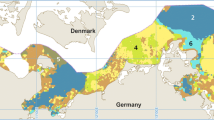Abstract
An extensive investigation based on the redox potential and grain size distributions was made on the sediment of a Venice Lagoon mud flat subjected to excessive growth of macroalgae. Redox potential and grain size measurements are proved useful “tracers” for, respectively, oxygen bearing and consuming processes in the water-sediment column and hydrodynamical behavior inside the mud flat. Depth measurements and a considerable number of sites with respect to the size of the area studied are needed to obtain an outline of the behavior of the water body in response to stress conditions caused by human activities. With respect to the top 15-cm-thick sediment layer where EH variations occur, the mud flat is subdivisible into sectors with different characteristics. Positive or near-zero EH values were recorded in zones characterized by sparse macroalgae growth and a high content of coarse sediments (diameter ⩾44 µm). On the contrary, very negative EH values were found in zones affected by overabundant macroalgae bloom and with a higher presence of fine-grained sediment (diameter ⩽44 µm). The clear relationships between algae presence in the mud flat and both the redox potential and grain size characteristics of the sediment emphasize the hydrodynamics as a “critical factor” determining the variations of the environmental conditions in the ecosystem.
Similar content being viewed by others
References Cited
Barillari, A., 1978, Prime notizie sulla distribuzione dei sedimenti superficiali nel bacino centrale della Laguna di Venezia: Atti dell'Ist. Veneto di Scienze, Lettere ed Arti, A.A. 1977–78, Tomo CXXXVI, p. 125–134.
Callame, B., 1968, Contribution a l'etude des potentiels d'oxydo-reduction dans les sediments marins: Cah. Oceanogr. v. 20, p. 305–319.
Cooper, L. R., R. L. Haverland, D. M. Hendricks and W. G. Knisel, 1984, Microtrac particle-size analyzer: An alternative particle-size determination method for sediment and soils: Soil Sci. v. 138, p. 138–146.
Krumbein, W. C., 1934, Size frequency distributions of sediments: J. Sed. Petrol. v. 4, p. 65–77.
Pini, R., and G. Guidi, 1989, Determinations of soil microaggregates with laser light scattering: Commun. Soil Sci. Plant Anal. v. 20, p. 47–59.
Plantz, P. E., 1984, Particle size measurements from 0.1 to 1000 µM based on light scattering and diffraction:in H. G. Barth, ed., Modern methods of particle size analysis: New York, John Wiley & Sons, p. 173–209.
Vigna Guidi, G., and R. Pini, 1989, Uso del porosimetro a intrusione di mercurio e tecniche a luce laser nell'analisi del terreno, Proc. of Giornate di studio sull'analisi del suolo, SISS-UNICHIN, Verona, Italy, p. 332.
Wentworth, C. K., 1922, A scale of grade and class terms for elastic sediments: J. Geol. v. 30, p. 377–392.
Zobell, C. E., 1946, Studies on redox potential of marine sediments: Bull. Am. Assoc. Petroleum Geol. v. 30, p. 477–512.
Zonta, R., G. Ghermandi, G. Perin, F. Simionato, R. V. Zonta, 1988, Un carotatore “a siringa” per il prelievo di campioni inalterati di sedimento nella Laguna di Venezia, Proc. of Incontri di Chimica Analitica dell'Ambiente (VI), Venice, Italy, 3–4 November, p. 33–34.
Author information
Authors and Affiliations
Rights and permissions
About this article
Cite this article
Argese, E., Cogoni, G., Zaggia, L. et al. Study on redox state and grain size of sediments in a mud flat of the Venice Lagoon. Environ. Geol. Water Sci 20, 35–42 (1992). https://doi.org/10.1007/BF01736108
Issue Date:
DOI: https://doi.org/10.1007/BF01736108




